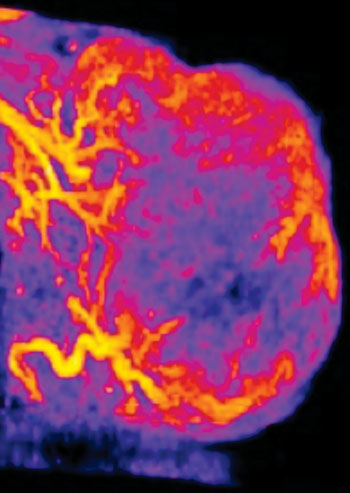A Subpopulation of Melanoma Cells Lacks VEGFR and Resists Antiangiogenic Therapy
By LabMedica International staff writers
Posted on 06 Nov 2014
Melanoma researchers have discovered a subpopulation of cancer cells that generate new blood vessels by expressing the vascular cell adhesion molecule PECAM1 (platelet endothelial cell adhesion molecule), but not VEGFR-2 (vascular endothelial growth factor), the major signaling molecule normally associated with new blood vessel formation (angiogenesis).Posted on 06 Nov 2014
PECAM-1 also known as cluster of differentiation 31 (CD31) is a protein that in humans is encoded by the PECAM1 gene found on chromosome 17. PECAM-1 plays a key role in removing aged neutrophils from the body. It is found on the surface of platelets, monocytes, neutrophils, and some types of T-cells, and makes up a large portion of endothelial cell intercellular junctions. This protein is a member of the immunoglobulin superfamily and is likely involved in leukocyte migration, angiogenesis, and integrin activation.

Image: An intensity-colored image of blood flow in a PECAM1-positive tumor (Photo courtesy of the University of North Carolina School of Medicine).
Investigators at the University of North Carolina (Chapel Hill, USA) were searching for an explanation as to why antiangiogenic drugs targeted at VEGFR often failed to prevent melanoma growth and spread. Towards this end, they reported in the October 22, 2014, online edition of the journal Nature Communications that they had isolated what appeared to be noncancerous endothelial cells from melanoma tumors. However, genetic analysis revealed that these cells resembled cancer cells rather than endothelial cells, and that these cells did not express VEGFR.
Instead of VEGFR these cells expressed the vascular cell adhesion molecule PECAM1 and participated in a PECAM1-dependent form of angiogenesis. Clonally derived PECAM1-positive tumor cells coalesced to form PECAM1-dependent networks in vitro, and they generated well-perfused, VEGF-independent channels in mice.
“These cells looked very different from normal endothelial cells in cultures,” said senior author Dr. Andrew C. Dudley, assistant professor of cell biology and physiology at the University of North Carolina. “We did not know what these cells were. Over the course of a year we found that these cells had several markers similar to melanoma cells. For a long time the hope has been that antiangiogenic therapies would starve tumors of the nutrients they need to thrive, but these drugs have not worked as well as we all had hoped. There are likely several reasons why these drugs have not been effective; our research suggests that these previously uncharacterized cells could be one of the reasons.”
Related Links:
University of North Carolina













